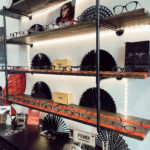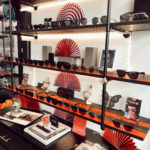
One of the optical displays with premium shelving that Pineda opted for in place of traditional frame boards, which, he said, do not convey a high-fashion message.
By Fabio Pineda
Sept. 21, 2022
The design of your optical displays determines whether or not patients make a purchase, and how satisfied they feel when they leave your office. In my practice, we designed optical displays that have been so effective, we have achieved a $600 per-patient average revenue, with some patients buying 5-9 pairs of designer glasses at one time, spending upwards of $4,000-$7,000 on purchases. Here is how we did it.
No Plastic Frame Boards Mounted on Walls
Here at Eye Boutique, our approach to frame boards is based on a traditional high-end approach to merchandising. I mean that we no longer use the tired approach of displaying merchandise in plastic frame boards mounted on the wall. Instead, we have custom-built shelves that elevate eyewear into the high-end accessory category it belongs to.
Over the years I noticed that the traditional customer becomes confused when merchandise is placed in frame boards. These boards are typically 4-5+ vertical rows with 18-24 pieces per row, all cramped into a space of less than five feet wide and repeated in any available space on a wall. This equates to sometimes thousands of frames on display at any given time. All of this only leads to merchandise becoming stale, higher returns/exchanges and less turn per brand.
Your own employees also tend to get bored of the products on display, which leads to them only selling what’s comfortable, easy and in their line of sight. Even worse, these boards eventually lose their original color and turn an unflattering yellow, which makes them even less appealing.
Fewer Products Means Higher ROI
I recommend reducing the amount of products displayed in your office to bring your overall monthly overhead costs down and create a less cluttered design aesthetic. Fewer merchandise means you won’t be in a rush to fill any and all spaces in your boards because product can be spread out evenly to give your displays the illusion of being freshly decorated.
You will always have the newest releases for your patients to choose from. They won’t see the same frames on display every time they visit your office. I have noticed in my office that fewer, fresher merchandise results in patients purchasing multiple pairs, especially of non-prescription sunglasses. We have achieved 40 percent sunglass sales. Fewer merchandise enables the selection process to run so smoothly it leaves patients with time to properly look for that second pair, or those sunglasses, we all want to sell.
Creating Displays that Match the Level of Merchandise You Sell
From the beginning, I knew my displays needed to match the look and feel of my office. If my overall look was to be modern/chic, then my optical displays had to be the same. We went with an industrial piping for hardware and a custom-wood finish that was achieved by having our carpenter make identical cuts to our size specifications, which are 5 ft. wide and stacked four shelves high with vertical spacing of 14 inches in between.
Display shelving color can be decided based on the color scheme of your office. However, before doing that, I suggest doing away with the all-white office motif. All you accomplish when you use white color pallets is the feel of a hospital space. It attracts dust like no other color, and that is not what you want when going for a luxury feel.

Shelving with sunwear in Pineda’s office. He says the practice has become a local destination for high-end sunglasses. This has enabled the practice to achieve 40 percent sunglass sales.
I decided to use a dark wood stain for our shelves to match the cabinets we use for storage underneath. The cost of a build-out will depend on the number of displays you wish to have, but a ballpark figure for shelving will be around $70-$100 for hardware (per display), $25 for wood (per display) and $30-$50 for stain (should be enough for whole store). Labor costs will depend on your ability to negotiate effectively with your carpenter.
Use Back Lighting
Another important factor is lighting and color of bulbs. Using back lighting will create depth in your displays and enable your products to pop. The easiest and most inexpensive way to achieve this is using LED strips that are all connected using your WiFi. If done correctly, and set on timers using the phone application that most LED strips come with, they will turn on and off automatically.
For overhead lighting, I suggest a spotlight style with a warm light. Lights that are too white tend to wash out the products and make them look less appealing.
The LED strips can be found for around $15-$29, and you can expect to use one per display. Your overhead lights will be slightly more expensive, at around $150-$300 depending on the length and color of the hardware. Installation of LED strips can be done yourself, but I recommend having an outside professional install the overhead lighting.
Use Large Mirrors to Break Up Displays
I suggest using large mirrors to split up your displays, so customers are able to easily see themselves in the eyewear at any given point in your office. An added benefit to using large mirrors is they make your space seem larger than it really is.
However, whatever you do, avoid adding mirrors as a backsplash element. While having mirrors behind your frames sounds like a good idea, it is actually unappealing to the eye, causing your store to seem disorganized with far too much product. For specialty products, glass-top tables with pull-out drawers is a good option, but always make sure they are free of clutter and smudges.
Dark Colors on Walls Help Achieve an Ultra-Modern, High-End Look
If your approach is an ultra-modern look with custom built-in shelves, make sure you use dark colors on your walls, whether it be a gray, navy or military green hues, to create a luxury feel.
Other Articles to Explore
Intentionally Designed Displays Change Behavior of Patients & Staff
Your patients can tell how much care and thought you put into your optical displays. When properly displaying your products, patients will treat your eyewear with more respect. They will likely be more gentle in how they handle your products, thanks to not having to pull them from frame holders or holes in your frame boards.
Having flat surfaces as part of your displays, rather than frame boards mounted on the wall, also allows your staff to know what frames need to be realigned, so everything is always in the best shape for patients to try on. This will equate to an enhanced patient experience because you will no longer have thousands of frames on display. The choices you offer will seem perfectly curated for your customers. Sales will be smoother, more controlled and will give the patient the right amount of time to make a decision, so you can provide great service while staying efficient and moving swiftly to your next customer.
Freshen Your Display Design About Every 5 Years
However you decide to display your frames, make sure you are always ready to make a change every five years or so. Follow the trends of all high-end fashion clothing stores, which keep their displays fresh. If you master the art of the high-end optical display, your office will be talked about by all of your patients as having the most stylish eyewear and ambiance. People in your community will know where to go for an eyewear shopping experience that matches their experience with other high-end retailers.
 Fabio Pineda is the owner of Eye Boutique in Houston, Texas. To contact him: eyeboutiquefabio@gmail.com
Fabio Pineda is the owner of Eye Boutique in Houston, Texas. To contact him: eyeboutiquefabio@gmail.com





















